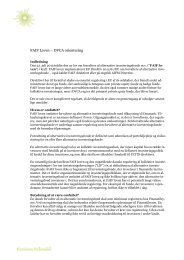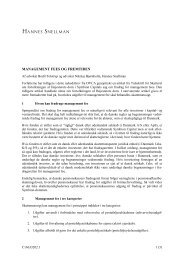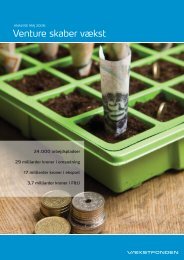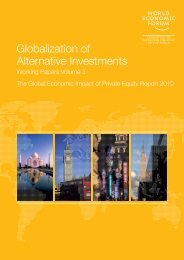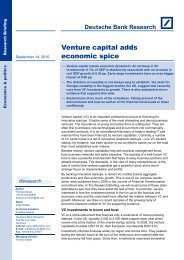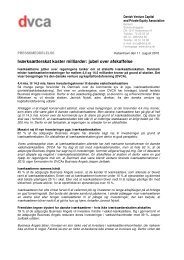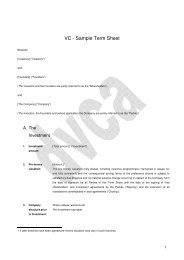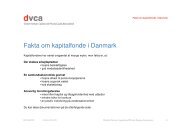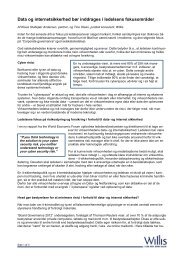A copublication of The World Bank and the - DVCA
A copublication of The World Bank and the - DVCA
A copublication of The World Bank and the - DVCA
You also want an ePaper? Increase the reach of your titles
YUMPU automatically turns print PDFs into web optimized ePapers that Google loves.
10 DOING BUSINESS 2011<br />
BOX 1.3<br />
O<strong>the</strong>r <strong>World</strong> <strong>Bank</strong> indicator sets on business regulations<br />
Women, Business <strong>and</strong> <strong>the</strong> Law (http://wbl.worldbank.org/)<br />
Data on legal differentiation on <strong>the</strong> basis <strong>of</strong> gender in 128 economies, covering 6 areas<br />
Investing Across Borders (http://iab.worldbank.org/)<br />
Data on laws <strong>and</strong> regulations affecting foreign direct investment in 87 economies, covering<br />
4 areas<br />
Subnational Doing Business (http://www.doingbusiness.org/Subnational/)<br />
Doing Business data comparing states <strong>and</strong> cities within economies (41 studies covering<br />
299 cities)<br />
<strong>World</strong> <strong>Bank</strong> Enterprise Surveys (http://www.enterprisesurveys.org/)<br />
Business data on more than 100,000 firms in 125 economies, covering a broad range <strong>of</strong><br />
business environment topics<br />
<strong>World</strong> <strong>Bank</strong> Group initiatives provide<br />
valuable complementary data based on<br />
a different approach. <strong>The</strong>se include <strong>the</strong><br />
<strong>World</strong> <strong>Bank</strong> Enterprise Surveys.<br />
As Doing Business continues to<br />
measure <strong>and</strong> track changes to business<br />
regulation around <strong>the</strong> world from <strong>the</strong><br />
perspective <strong>of</strong> local firms, <strong>the</strong>se <strong>and</strong><br />
o<strong>the</strong>r data sets provide a rich base for<br />
policy makers <strong>and</strong> researchers alike to<br />
continually test <strong>and</strong> improve <strong>the</strong>ir underst<strong>and</strong>ing<br />
<strong>of</strong> what works <strong>and</strong> what does<br />
not—<strong>and</strong> why.<br />
utilities that provide a critical economic<br />
service, exposes customers to potential<br />
abuse <strong>and</strong> might mask excessively high<br />
utility cost structures. In many economies<br />
it is customers, not <strong>the</strong> utility, that<br />
must take on <strong>the</strong> complex process <strong>of</strong><br />
coordinating clearances across multiple<br />
government agencies, because opportunities<br />
to streamline <strong>the</strong> coordination<br />
between <strong>the</strong> utility <strong>and</strong> o<strong>the</strong>r agencies<br />
are missed. In many middle-income<br />
economies customers also face unnecessarily<br />
complex procedural steps for fire<br />
<strong>and</strong> wiring safety checks, while some<br />
governments in Sub-Saharan Africa <strong>and</strong><br />
<strong>the</strong> Middle East <strong>and</strong> North Africa omit<br />
requirements for such checks entirely.<br />
<strong>The</strong>se <strong>and</strong> o<strong>the</strong>r findings suggest that<br />
many governments <strong>and</strong> regulators could<br />
ease a critical bottleneck for businesses by<br />
encouraging reforms around <strong>the</strong> electricity<br />
connection process. Requiring more<br />
transparency in utility connection pricing<br />
<strong>and</strong> encouraging better interagency<br />
coordination could be a start.<br />
REFINING THE EMPLOYING WORKERS<br />
INDICATORS<br />
Maintaining <strong>and</strong> creating productive<br />
jobs <strong>and</strong> businesses is a priority for<br />
policy makers around <strong>the</strong> world, particularly<br />
in <strong>the</strong>se times. Good labor regulation<br />
is flexible enough to help those<br />
currently unemployed or working in <strong>the</strong><br />
informal sector to obtain new jobs in<br />
<strong>the</strong> formal sector. At <strong>the</strong> same time, it<br />
provides adequate protections for those<br />
already holding a job, so that <strong>the</strong>ir productivity<br />
is not stifled. Finding <strong>the</strong> right<br />
balance is no easy task.<br />
To inform policy makers <strong>and</strong> researchers,<br />
Doing Business is working to<br />
refine <strong>the</strong> methodology for its employing<br />
workers indicators <strong>and</strong> exp<strong>and</strong> <strong>the</strong> data<br />
set. Based on input from a consultative<br />
group <strong>of</strong> experts <strong>and</strong> stakeholders, new<br />
thresholds are being introduced to recognize<br />
minimum levels <strong>of</strong> protection in line<br />
with relevant conventions <strong>of</strong> <strong>the</strong> International<br />
Labour Organization—those for<br />
minimum wage, paid annual leave <strong>and</strong><br />
<strong>the</strong> maximum number <strong>of</strong> working days<br />
per week. This provides a framework<br />
for balancing worker protection against<br />
employment restrictions in <strong>the</strong> areas<br />
covered by <strong>the</strong> indicators. In addition,<br />
new data are being collected on regulations<br />
according to length <strong>of</strong> job tenure (9<br />
months, 1 year, 5 years <strong>and</strong> 10 years). <strong>The</strong><br />
annex on employing workers presents<br />
initial findings from this work.<br />
INITIATIVES COMPLEMENTING DOING<br />
BUSINESS<br />
<strong>The</strong> <strong>World</strong> <strong>Bank</strong> Group has introduced<br />
additional benchmarking indicator sets<br />
that complement <strong>the</strong> perspectives <strong>of</strong><br />
Doing Business (box 1.3). <strong>The</strong> Women,<br />
Business <strong>and</strong> <strong>the</strong> Law database, launched<br />
in March 2010, for <strong>the</strong> first time provides<br />
objective measures <strong>of</strong> differential treatment<br />
based on gender. Investing Across<br />
Borders, launched in July 2010, provides<br />
measures <strong>of</strong> business regulations from<br />
<strong>the</strong> perspective <strong>of</strong> foreign investors.<br />
Subnational Doing Business reports, introduced<br />
in 2004, provide insights into<br />
variations within large economies. O<strong>the</strong>r<br />
1. Some 656 articles have been published<br />
in peer-reviewed academic journals, <strong>and</strong><br />
about 2,060 working papers are available<br />
through Google Scholar (http://scholar.<br />
google.com).<br />
2. Klapper, Lewin <strong>and</strong> Quesada Delgado<br />
(2009). Entry rate refers to newly registered<br />
firms as a percentage <strong>of</strong> total registered<br />
firms. Business density is defined as<br />
<strong>the</strong> number <strong>of</strong> businesses as a percentage<br />
<strong>of</strong> <strong>the</strong> working-age population (ages<br />
18–65).<br />
3. International Labour Organization (ILO)<br />
data.<br />
4. OECD (2004b); ILO <strong>and</strong> SERCOTEC<br />
(2010, p. 12); South Africa, Department<br />
<strong>of</strong> Trade <strong>and</strong> Industry (2004, p. 18);<br />
China, State Administration for Industry<br />
<strong>and</strong> Commerce, http://www.saic.gov<br />
.cn/english/; <strong>and</strong> Ayyagari, Beck <strong>and</strong><br />
Demirgüç-Kunt (2007).<br />
5. Bedi (2009).<br />
6. In <strong>the</strong> United Kingdom, for example,<br />
19,077 companies were liquidated in<br />
2009, 22.8% more than in <strong>the</strong> previous<br />
year.<br />
7. <strong>World</strong> <strong>Bank</strong> conference, “<strong>The</strong> Singapore<br />
Experience: Ingredients for Successful<br />
Nation-Wide eTransformation,” Singapore,<br />
September 30, 2009.<br />
8. Doing Business has tracked regulatory<br />
reforms affecting businesses throughout<br />
<strong>the</strong>ir life cycle—from start-up to closing—in<br />
174 or more economies since<br />
2005. Between 2003 <strong>and</strong> 2005 Doing<br />
Business added 5 topics <strong>and</strong> increased<br />
<strong>the</strong> number <strong>of</strong> economies covered from<br />
133 to 174. For more information on <strong>the</strong><br />
motivation for <strong>the</strong> 5-year measure <strong>of</strong> cumulative<br />
change (DB change score), see<br />
About Doing Business. For more on how<br />
<strong>the</strong> measure is constructed, see Data<br />
notes.



